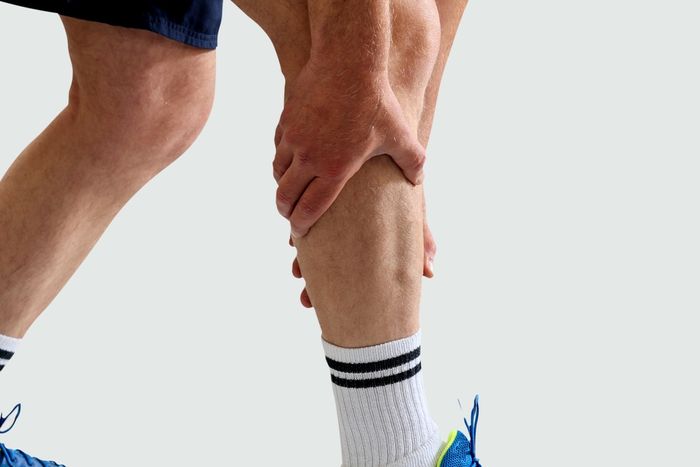Peroneal Tendonitis Exercises & Stretches to Relieve Symptoms
Published May 24, 2022.

Peroneal tendonitis, a common cause of lateral ankle pain, is related to inflammation arising in the lateral peroneal muscles. Inflammation occurs due to the increased load and overuse of the tendons in the lower leg, commonly seen in runners whose ankles turn inward or overpronate as the foot strikes the ground. The outward roll of the foot while running places increased strain on the peroneal muscles, eventually leading to pain and inflammation arising in the area.
Symptoms and Causes of Peroneal Tendonitis
Symptoms of peroneal tendonitis include:
- Direct and localized pain along the length of the tendon
- Swelling or redness around the tendon
- Pain that worsens with activity and improves with rest
- Thickened tendons, seen over time
Causes of peroneal tendonitis include:
- Overuse of the tendons in the lower leg
- Increase in activities that repetitively load the peroneal muscles
- Improper or old footwear, leading to increased strain placed on the peroneal muscles
- Biomechanical misalignment in the body
The risk factors that could lead to peroneal tendonitis include:
- High foot arches
- Weakened lower limb muscles
- Improper footwear
- Age may increase the chances of developing this condition
- Tightened calf muscles
- Poor foot biomechanics
- Inappropriate training techniques
Exercises for Peroneal Tendonitis
Ankle Exercises
Start by sitting on a chair and bring one leg up to rest your foot over the opposite knee. Move your foot up and down and side to side to warm up the ankle muscles. Repeat on both feet several times. Next, apply gentle resistance to the foot with your hand as you try to pull the foot inwards. Hold for 10 seconds and release. Next, push your foot outward against the resistance of your hand and hold for 10 seconds.
Heel Raises
Standing on a soft, flat surface with support if needed, slowly rise onto the toes of both feet at the same time. Be sure to engage the calf muscles. Repeat 10–15 times
Towel Stretch
Sitting on a soft surface with your legs outstretched in front of you, wrap a towel around the toes of one foot. Pull back, gently applying a stretch to the calf and foot muscles. Hold for 20–30 seconds and repeat.
Heel raises and towel stretches can also help heal a sprained ankle.
Ankle Exercises with Elastic Bands
By using an elastic band, you can do exercises that can directly target the perineal muscles of the lower leg. Start by sitting with your legs out in front of you, placing the elastic band around the forefoot of one foot. Pull the foot inwards while trying to maintain normal alignment of the foot. This will engage the peroneal muscles of the leg. Contract and hold for 5 seconds, then relax. Repeat on the other leg.
Please note that exercises should not cause pain during or after exercise. Be sure to rest if you experience pain or inflammation.
Preventing Peroneal Tendonitis
Peroneal tendonitis can be prevented by using proper supportive footwear and arch supports throughout the day to minimize pressure on the peroneal tendons as you walk or run. Supportive shoes that prevent the outward roll of the foot should help prevent ankle pain when walking or running.
Rest, Ice, and Elevation
Rest will alleviate symptoms of peroneal tendonitis and allow inflammation in the tendon to reduce before going back to your regular exercise. Ice can also be applied alongside elevating the ankle to reduce pain and inflammation in the area further.
Stretching
Stretching can have significant benefits in maintaining the alignment of the collagen fibers as they heal in the peroneal tendons and muscle fibers.
Medication
Medication can be prescribed by a medical professional to help you manage pain and inflammation. Anti-inflammatory drugs, such as ibuprofen and diclofenac, will greatly improve these symptoms.
Massaging
You can gently massage the area along the tendon where the pain is located using a topical analgesic gel or lotion to relieve pain. The massage also brings blood to the area, promoting the healing of the tissue.
Physical Therapy
A physical therapist will be able to guide you through the rehabilitation process and other treatment modalities that could help you heal and return to sport safely.
How Long Is Recovery From Peroneal Tendonitis?
Recovering from peroneal tendonitis can take a fair amount of time. It can take 6–8 weeks to improve with limited activity.
Surgical intervention is rare but not uncommon. It is usually a last resort if all conservative management strategies have failed to manage pain. Scar tissue around the tendon that has developed through countless healing processes should be surgically removed to ensure smooth gliding of the tendon. Please consult with a medical professional regarding starting exercise therapy after surgery.
Sometimes sudden ankle pain can occur due to different types of ankle sprains or even ankle arthritis. If you're unsure about the cause of your ankle pain, take a look at the ankle pain symptom checker.








